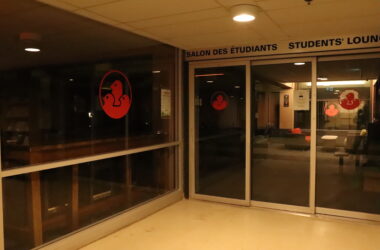With the spring thaw on the horizon, students are already swerving away from massive puddles on street corners and sidewalks. To better understand why the temporary flooding is so severe, The McGill Tribune looked into how Montreal handles its wastewater.
Where does the water go?
According to the City of Montreal, the city’s drainage system gathers 2.5 million cubic metres of wastewater on a normal day and up to eight million cubic metres on a wet day. Almost all of this water is treated by the J.R-Marcotte water treatment plant located at the base of the Island of Montreal, which is also the third largest water plant in the world. Every litre of water that flows through the plant is filtered for garbage and particles then given a chemical treatment that binds smaller particles together so that they too can be filtered out. Once treated, the water is dumped into the Saint Lawrence River. Currently, Montreal does not sanitize its wastewater, although there are plans to open a new sanitization plant within the next three years.
Why isn’t the water sanitized?
Sanitizing millions of litres of wastewater is expensive, time-consuming, and has its own environmental impact: Nature Education estimates that wastewater sanitization accounts for three per cent of global electricity production and five per cent of all greenhouse gas emissions worldwide. Professor Jim Nicell, dean of the Faculty of Engineering at McGill, explained that the most sustainable solution for an environmental problem may not be the obvious one.
“A few years ago, there was an issue where [Montreal] needed to divert wastewater directly into the St. Lawrence river in order to repair a pipe,” Nicell said. “From an engineering perspective, that’s a non-issue: You look at the size of the river, you look at the level of dilution, [and you find that] nature’s not going to feel it. Now, consider someone that would instead want to build a giant basin to hold the dirty water because they were really concerned about the environment. But, what about the environmental and economic resources that would be required in order to build a temporary structure to hold this water? That’s not a wise use of resources in our efforts to protect the environment.”
How is the water transported?
Most of the city is serviced by a combined sewerage system which transports both sewage and storm water. There is a drainage pipe underneath every street in Montreal, the smallest of which are only 30 centimetres in diameter and the largest being over four metres wide. All of the water in the combined system is eventually moved into one of two massive pipes. These underground rivers, called interceptors, are over five metres wide and, ultimately, transport the water to the treatment plant.
Why are there massive puddles on every street then?
Sewerage systems have a maximum capacity and, when reached, the system must either dump untreated water directly into a holding facility or water source or else risk flooding thousands of businesses and homes. Nicell, who has worked in environmental engineering for over 25 years, explained that engineers try to avoid this issue by intentionally designing storm drains and streets to drain water at a slow rate.
“If you allow the water to flood as quickly as possible down the sewer in order to keep everyone’s feet dry, that creates a massive peak of flow that may overflow the sewer […and] flood businesses and homes that are blocks away,” Nicell said. “So, what we’ll do is purposely allow the water to pool and then slowly drain down into the system so that it doesn’t flood.”
However, he also pointed out that the flooding near campus can be excessive.
“I can’t always say [the flooding] is by design,” Prof. Nicell said. “For instance, the [drain] by the Roddick Gates is not good [….] Sometimes, the design is good, but the contractors make a mistake during construction.”










Every day in Montreal a city of two million there must be at least 50 million gallons of waste water which includes shit going into the St Lawrence River. And in a month billions of gallons of waste water from Montreal alone goes into the ocean. In a day the waste water from cities all over the world must be constantly polluting our oceans. And people are drawn to sunlit beaches to swim in shitty water. And increasingly shitty water. Daily.